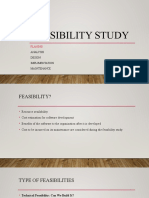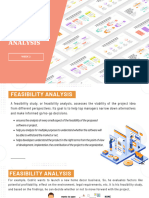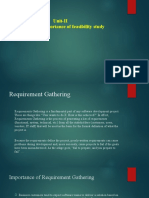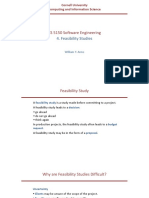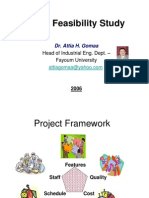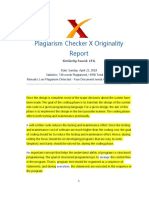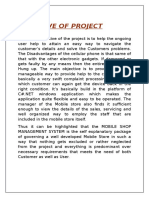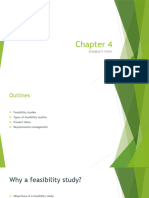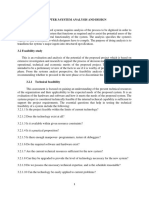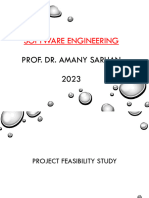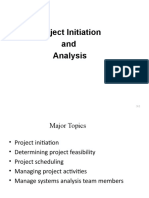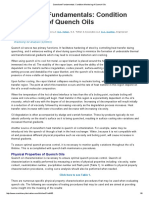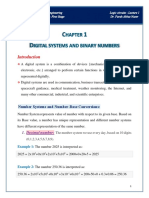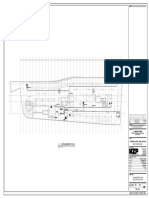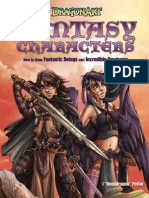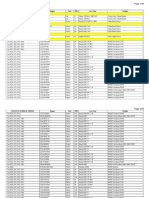Software Engineering for Students-
4th Edition
Chapter 3
Software Feasibility Study
Lecturer : Eng-Moha Ali
mysomville.info@gmail.com
Somaville University
2023
� Chapter Objectives
Understands what is feasibility study
Types of feasibility study in software required
Explains the role of a feasibility study process
Management summary
Summary of chapter
2
�3.1. Introduction
• Every software project begins with a
judgment as to whether the project is
worthwhile or not. This is called a feasibility
study.
• Sometimes this assessment is carried out in a
detailed and systematic procedure and
process which deeply focus on the
implemennt cost benefit analysis which
always named Total Cost Ownership (TCO)
• While feasibility study must to develop
project sofware project as to reliable, robust ,
accountibility for budget and completion
deadline time frame date allocated . 3
� 3.2. Understands what is
feasibility
• Feasibility study
is defined as the practical extent to
which a project can be performed successfully.
Or means
• Feasibility study is performance cost-benefit
analysis procedure.
• To evaluate feasibility, a feasibility study is
performed, which determines whether the solution
considered to accomplish the requirements is
practical and workable in the software. Information
such as resource availability, cost estimation for
software development, benefits of the software to
the organization after it is developed and cost to be
incurred on its maintenance are considered during
the feasibility study. 4
�3.3. The objective of the
feasibility study
• The objective of Feasibility study to establish the
reasons for developing the software that is
acceptable to users, adaptable to change and
conformable to established standards.
• Various other objectives of feasibility study are
listed below.
a.To analyze whether the software will meet
organizational requirements.
b.To determine whether the software can be
implemented using the current technology and
within the specified budget and schedule.
c.To determine whether the software can be
integrated with other existing software 5
�3.4. Types of Feasibility study
• The various types of feasibility that
are commonly considered as the
following steps
1. Technical feasibility study
2. Operational feasibility study
3. Economic feasibility study
4. Report feasibility study
5. Schedule feasibility study.
6
�3.4.1. Technical feasibility
study
• Technical feasibility assesses the current
resources (such as hardware and software)
and technology, which are required to
accomplish user requirements in the software
within the allocated time and budget.
• For this, the software development team
ascertains whether the current resources and
technology can be upgraded or added in the
software to accomplish specified user
requirements.
• Technical feasibility also performs the
following tasks.
7
�3.4.1 Technical feasibility
study
• Technical feasibility also performs the
following tasks.
a.Analyzes the technical skills and capabilities
of the software development team members.
b.Determines whether the relevant technology
is stable and established.
c.Ascertains that the technology chosen for
software development has a large number of
users so that they can be consulted when
problems arise or improvements are
required.
8
�3.4.1 Technical feasibility
study
• Technical feasibility also involves the
evaluation of the hardware, software, and
other technical requirements of the proposed
system.
• Example of tabular format technical software
& hardware
9
�3.4.2. Operational feasibility
study
• Operational feasibility assesses the extent
to which the required software performs a
series of steps to solve business problems
and user requirements.
• This feasibility is dependent on human
resources staffing (software development
team) and involves visualizing whether the
software will operate after it is developed
and be operative once it is installed.
• Operational feasibility also performs the
following tasks.
10
�3.4.2. Operational feasibility
study
• Operational feasibility also performs the
following tasks.
a.Determines whether the problems anticipated
in user requirements are of high priority.
b.Determines whether the solution suggested by
the software development team is acceptable.
c. Analyzes whether users will adapt to new
software.
d.Determines whether the organization is
satisfied by the alternative solutions proposed
by the software development team.
11
� 3.4.3. Economic feasibility
•
study
Economic feasibility determines whether
the required software is capable of
generating financial gains for an
organization.
• It involves the cost incurred on the
software development team, estimated
cost of hardware and software, cost of
performing feasibility study, and so on.
• For this, it is essential to consider
expenses made on purchases (such as
hardware purchase) and activities required
to carry out software development. 12
� 3.4.3. Economic feasibility
• study
In addition, it is necessary to consider the
benefits that can be achieved by developing
the software
• Software is said to be economically feasible
if it focuses on the issues listed below.
a.Cost incurred on software development to
produce long-term gains for an organization.
b.Cost required conducting full software
investigation (such as requirements
elicitation and requirements analysis).
c. Cost of hardware, software, development
team, and training 13
�3.4.4. Report feasibility study
• Report feasibility study is like report
writing, which is the conclusion of the
feasibility study by the software
development team.
• It includes the recommendations
whether the software development
should continue.
• This report may also include information
about changes in the software scope,
budget, and schedule and suggestions
of any requirements in the system. 14
� 3.4.4. Schedule feasibility
study
• Schedule feasibility is the process of
assessing the degree to which the potential
time frame and completion dates for all
major activities within a project meet
organizational deadlines and constraints for
affecting change.
• How long a project will run, analyzed by the
schedule feasibility study?
• A feasibility study not only collects the
entire requirement and estimates the cost
benefit analysis, but also calculate the total
time for the completion of any project for
15
deadline allocated.
� 3.5. The role of feasibility
study process
• Feasibility study comprises the following steps.
1. Information assessment: Identifies information
about whether the system helps in achieving the
objectives of the organization. It also verifies that
the system can be implemented using new
technology and within the budget and whether the
system can be integrated with the existing system.
2. Information collection: Specifies the sources
from where information about software can be
obtained. Generally, these sources include users
(who will operate the software), organization
(where the software will be used), and the software
development team (which understands user
requirements and knows how to fulfill them in
16
software).
� 3.5. The role of feasibility
3.study
General process
information: Describes the purpose
and scope of feasibility study. It also describes
system overview, project references, acronyms
and abbreviations, and points of contact to be
used.
4. System overview provides description about
the name of the organization responsible for the
software development, system name or title,
system category, operational status, and so on.
5. Project references provide a list of the
references used to prepare this document such
as documents relating to the project or previously
developed documents that are related to the
project. 17
� 3.5. The role of feasibility
study process
6. Acronyms and
abbreviations provide a list of the
terms that are used in this document
along with their meanings.
7. Points of contact provide a list of
points of organizational contact with
users for information and coordination.
For example, users require assistance to
solve problems (such as troubleshooting)
and collect information such as contact
number, e-mail address, and so on 18
�3.6. Management summary
• Management summary: Provides the following
information steps:
1. Environment: Identifies the individuals
responsible for software development. It provides
information about input and output requirements,
processing requirements of the software and the
interaction of the software with other software. It
also identifies system security requirements and the
system's processing requirements
2. Current functional procedures: Describes the
current functional procedures of the existing
system, whether automated or manual. It also
includes the data-flow of the current system and the
number of team members required to operate and
maintain the software. 19
�3.6. Management summary
3. Functional objective: Provides information
about functions of the system such as new
services, increased capacity, and so on.
4. Performance objective: Provides
information about performance objectives such
as reduced staff and equipment costs, increased
processing speeds of software, and improved
controls.
5. Assumptions and constraints: Provides
information about assumptions and constraints
such as operational life of the proposed software,
financial constraints, changing hardware,
software and operating environment, and
20
availability of information and sources.
�3.6. Management summary
4. Methodology: Describes the methods that
are applied to evaluate the proposed software in
order to reach a feasible alternative. These
methods include survey, modeling,
benchmarking, etc.
5. Evaluation criteria: Identifies criteria such
as cost, priority, development time, and ease of
system use, which are applicable for the
development process to determine the most
suitable system option.
6. Recommendation: Describes a
recommendation for the proposed system. This
includes the delays and acceptable risks. 21
�3.6. Management summary
7. Proposed software: Describes the overall
concept of the system as well as the procedure
to be used to meet user requirements.
•In addition, it provides information about
improvements, time and resource costs, and
impacts.
•Improvements are performed to enhance the
functionality and performance of the existing
software.
•Time and resource costs include the costs
associated with software development from its
requirements to its maintenance and staff
training. 22
�3.6. Management summary
Impacts describe the possibility of future
happenings and include various types of impacts
as listed below.
a.Equipment impacts: Determine new equipment
requirements and changes to be made in the
currently available equipment requirements.
b.Software impacts: Specify any additions or
modifications required in the existing software and
supporting software to adapt to the proposed
software.
c.Organizational impacts: Describe any changes
in organization, staff and skills requirement.
23
�3.6. Management summary
d. Operational impacts: Describe effects on
operations such as user-operating procedures,
data processing, data entry procedures, and so
on.
e. Developmental impacts: Specify
developmental impacts such as resources
required to develop databases, resources
required to develop and test the software,
and specific activities to be performed by
users during software development.
24
�3.6. Management summary
f. Security impacts: Describe security
factors that may influence the
development, design, and continued
operation of the proposed software .
g. Alternative systems: Provide
description of alternative systems, which
are considered in a feasibility study. This
also describes the reasons for choosing a
particular alternative system to develop
the proposed software and the reason for
rejecting alternative systems
25
�Chapter Summary
• Feasibility study is performance
cost-benefit analysis procedure.
• Every software project begins
with a judgment as to whether the
project is worthwhile or not.
• The objective of Feasibility study
to establish the reasons for
developing the software that is
acceptable to user’s needs.
26
� Chapter Summary
• Technical feasibility assesses the current
resources like hardware and software and
technology, which are required developing
product budget costs estimated.
• Operational feasibility assesses the extent
to which the required the budget costs for
human resource staffing training software
performs a series of steps to solve
business problems to be operated
• Economic feasibility determines whether
the required software is capable of
generating financial gains for an
27
� Chapter Summary
• Schedule feasibility is the process of
assessing the degree to which the potential
time frame and completion of deadline for
project allocated .
• Report feasibility study is like report
writing, which is the conclusion of the
feasibility study by the software
development team.
• Information assessment is to Identifies
information about whether the system
helps in achieving the objectives of the
organization. 28
� Chapter Summary
• Information collection is to
Specifies the sources from where
information about software can be
obtained
• Project references is to provide a
list of the references used to
prepare this document sourced
from others.
29
� Chapter Summary
• Acronyms and abbreviations provide a list of
the terms that are used in this document along
with their meanings.
• Proposed software is to describes the overall
concept of the system as well as the procedure
to be used to meet user requirements.
• Organizational impacts is to describe any
changes in organization, staff and skills
requirement.
• Functional objective is to provides information
about functions of the system such as new
services, increased capacity, and so on.
30
�Chapter 3
complete
31



